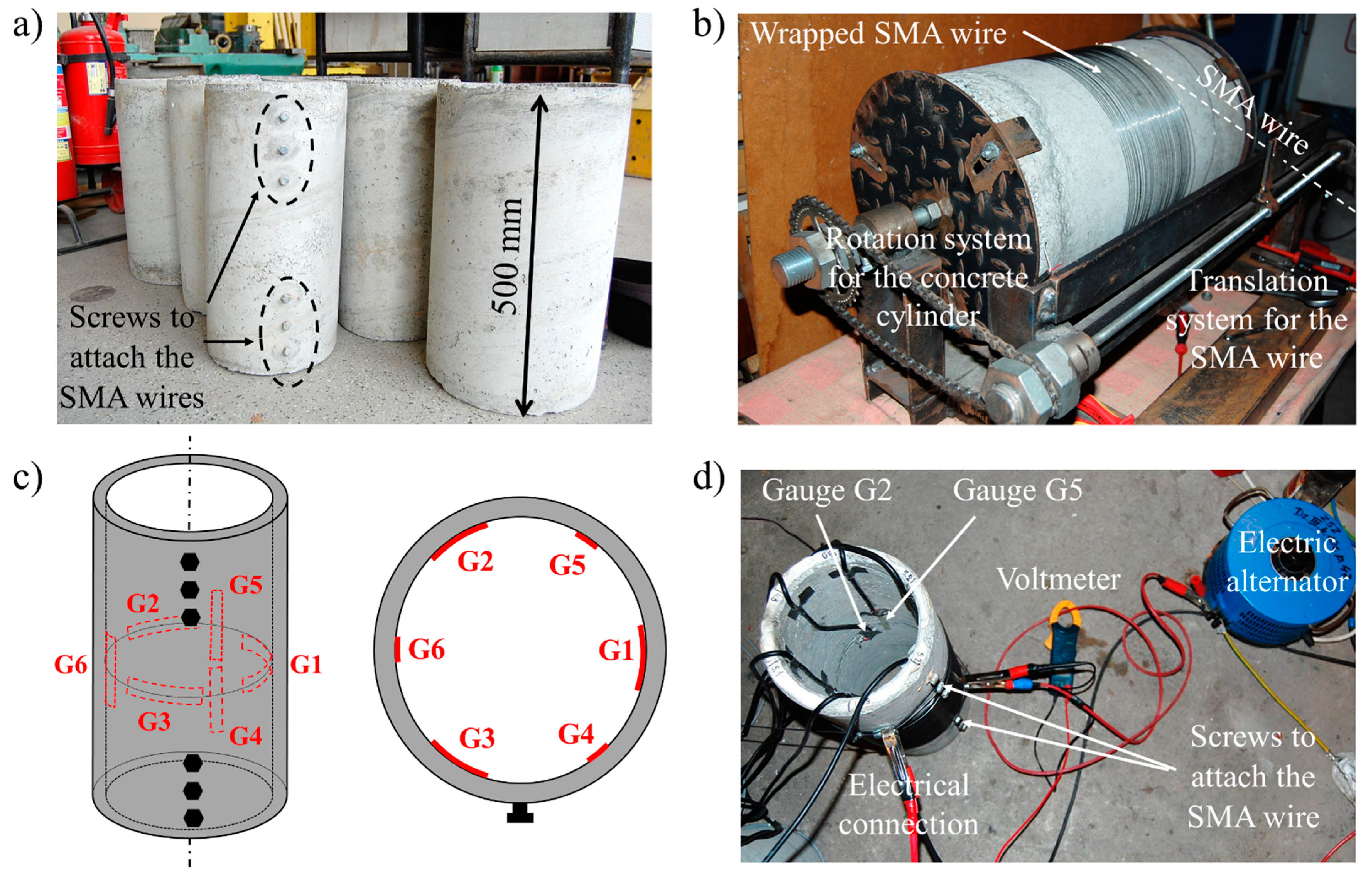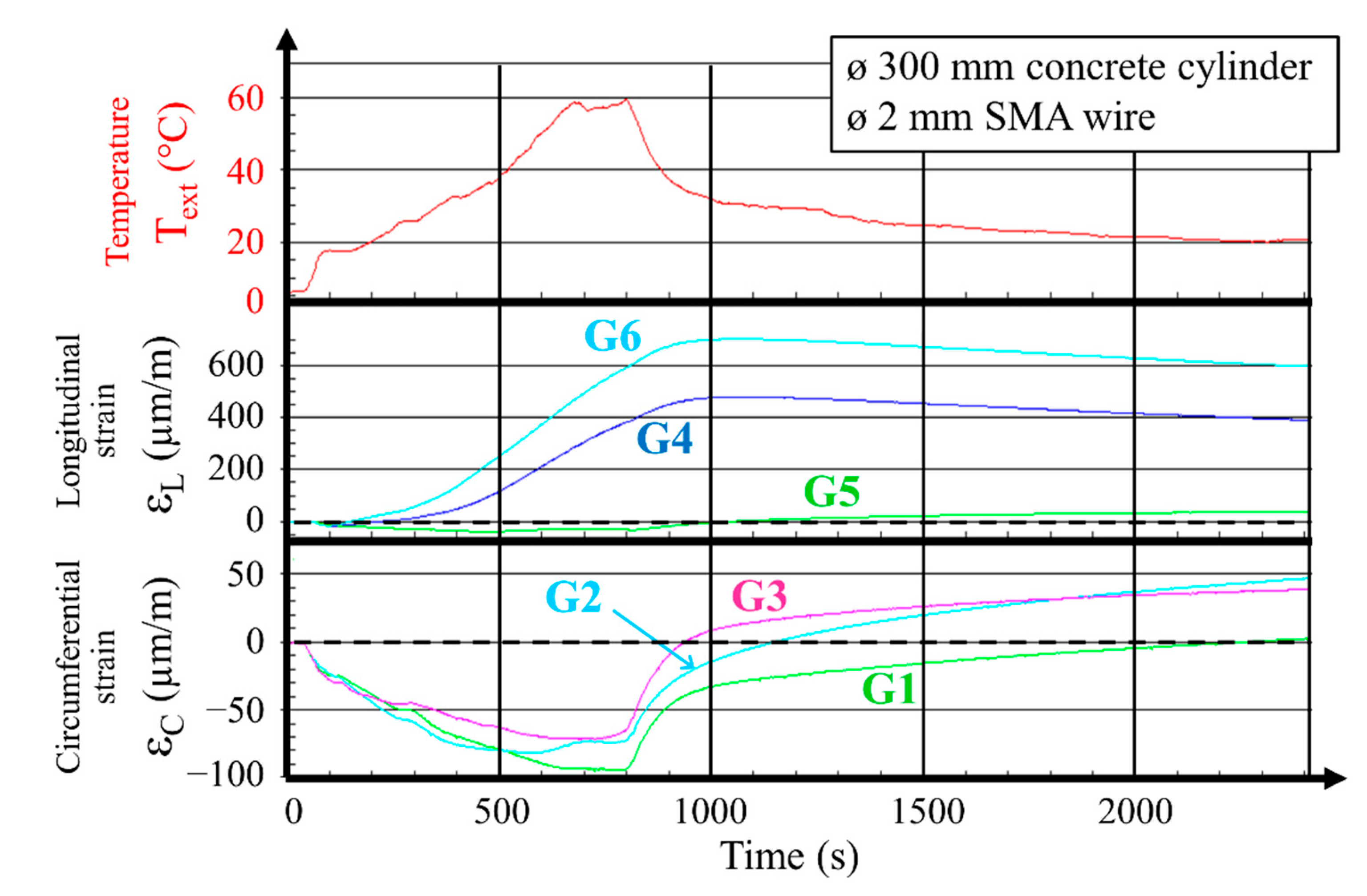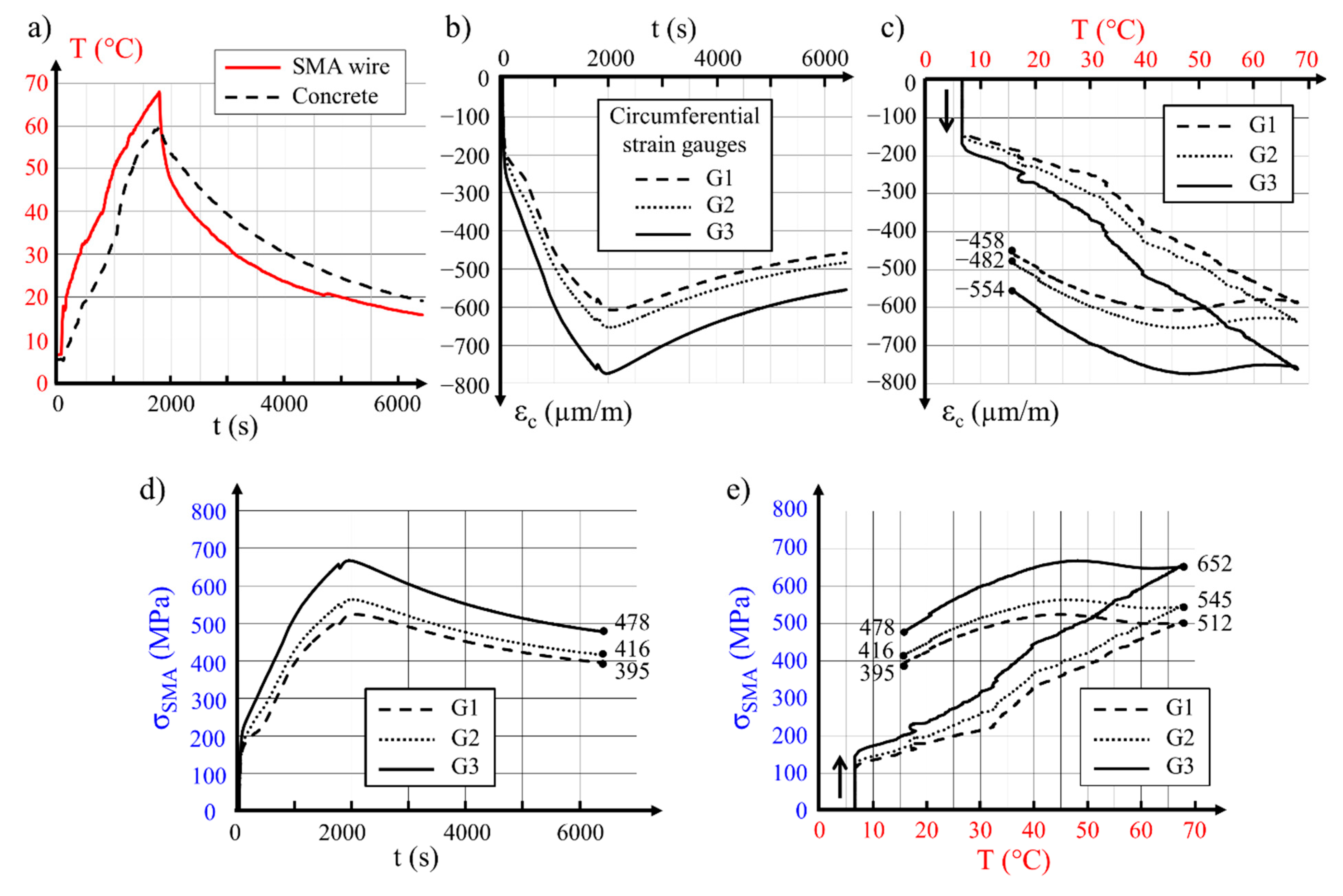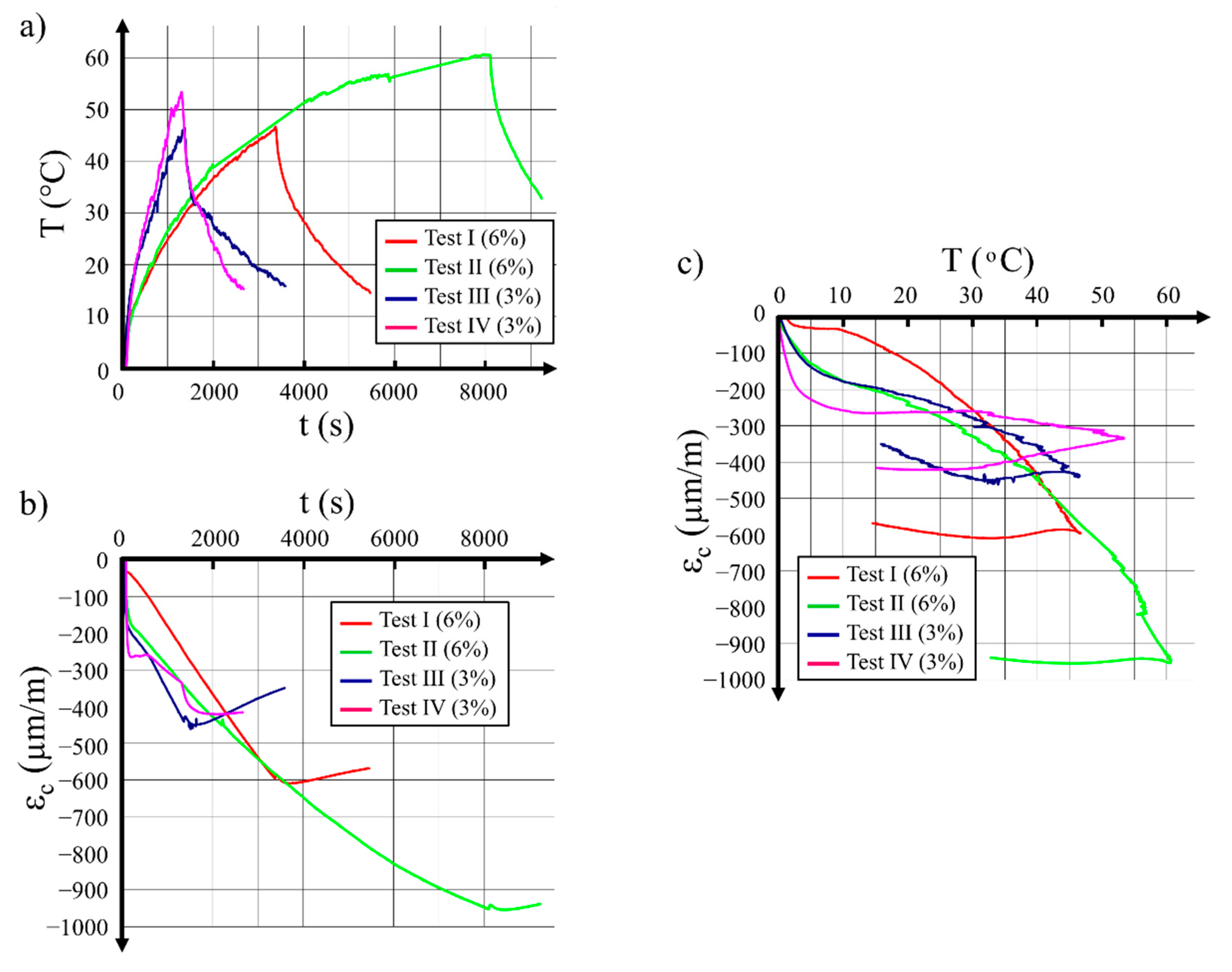The Application of Ni–Ti SMA Wires in the External Prestressing of Concrete Hollow Cylinders
Abstract
:1. Introduction
2. Properties of the SMA Wires Used
3. Description and Preparation of the Concrete Samples
4. Procedure for the Creation of Prestress States in Concrete Hollow Cylinders with Use of SMA Wires
- The wire was subjected to heating until a temperature exceeding the value of Af was obtained for the purpose of initialization in austenite phase.
- The wire was cooled to the ambient temperature. Let us recall that the ambient temperature was higher than Ms. As a consequence, transformation to martensite did not occur, and the material austenitic state was preserved. At this time, anchoring loops were formed on the wire ends.
- For part of the testing, controlled predeformation (residual strain) was applied to the SMA wire with the relevant pulling equipment.
- The concrete specimen was installed in the specially designed winding apparatus shown in Figure 2b.
- The SMA wire loop was attached to the anchoring bolt on the external surface of the hollow cylinder, and the wire was wound on the surface.
- During the whole winding process, the ambient temperature was kept constant, and the SMA wire was protected from any temperature increase, especially from contact with hands.
- After winding, the wire end loop was fixed to the anchorage bolt.
- The following equipment was connected to the HBM QuantumX MX840A measuring amplifier with the use of shielded cables:
- ○
- strain gauges installed on the internal surface of two hollow concrete cylinders—the tested cylinder and a reference cylinder (Figure 2c);
- ○
- two temperature sensors, one for measuring temperature of the SMA wire and one for the internal surface of the concrete cylinder .
- An ammeter and voltmeter were used for monitoring the current parameters during the test.
- At the initiation of the test, the SMA wire was connected to an electric current. An appropriate current source was used in dependence on the electric resistance of the SMA wire. The temperature increase in the SMA wire was controlled.
- After achieving the required temperature of the wire, the electrical current was disconnected and a temperature decrease was observed until it returned to the ambient temperature.
5. Standard Features of the Experimental Procedure
5.1. Setup of the Specimens and the Measurement Equipment
- circumferential gauges—G1, G2, and G3;
- vertical gauges—G4, G5, and G6.
5.2. Application of Electrical Current for Prestressing of Concrete Hollow Cylinders
5.3. Equations for the Analysis of the Combined Effect of Prestressing and Thermal Dilatation on Concrete Strain in Hollow Cylinders
6. Results of the Performed Tests
6.1. Results Obtained from Tests of Concrete Hollow Cylinders Prestressed with SMA Wire Without Preliminary Deformation
6.2. Concrete Hollow Cylinders Prestressed with the Preliminary Deformed SMA Wire
6.2.1. Experimental Setup
- For the hollow cylinder with an external diameter of 200 mm, there were 45 windings of the wire placed in the central strip of the hollow cylinder surface, which amounted to a width of approximately 0.17 m.
- For the hollow cylinder with an external diameter of 250 mm, there were 38 windings of the wire placed in the central strip of the hollow cylinder surface, which amounted to a width of approximately 0.15 m.
- For the hollow cylinder with an external diameter of 300 mm, there were 32 windings of the wire placed in the central strip of the hollow cylinder surface, which amounted to a width of approximately 0.13 m.
6.2.2. Test Results and Stresses Calculated in the SMA
7. Analysis of Test Results
7.1. Discussion of the Results from Tests and Analysis
- P—pressure [MPa];
- σc,SMA—circumferential compression stress in concrete at the residual state [MPa];
- σres—stress in shape memory wire at the residual state [MPa];
- FSMA—force in SMA wire remaining after prestress execution [N].
7.2. The Influence of Preliminary Wire Deformation on Prestressing Effectiveness
- Test I (initial predeformation 6%), −545 μm/m;
- Test II (initial predeformation 6%), −547 μm/m;
- Test III (initial predeformation 3%), −428 μm/m;
- Test IV (initial predeformation 3%), −305 μm/m.
- SMA wire predeformed to a higher initial strain value needed a longer duration of electrical current flow to reach the expected temperature. In the case of wire with a diameter of 2 mm predeformed to 6%, the time needed to reach a temperature of 45 °C was three times longer than the time needed to heat the same wire predeformed to 3%.
- As a consequence of the longer heating time required for the wire predeformed to 6%, the concrete hollow cylinder was also heated more and this provoked an additional thermal deformation of the concrete.
- At a wire temperature of 45 °C, the circumferential strain of the concrete in the hollow cylinder prestressed with the wire predeformed to 6% was around 50% higher than the strain in the concrete hollow cylinder with the wire predeformed to 3%; the measured concrete strain included the influence of prestressing with the SMA wire and the thermal deformation of the concrete.
- It can be seen in Figure 5c that, for the hollow cylinder prestressed with wire subjected to 6% predeformation, a higher final strain was preserved after cooling, and this meant that the residual stress (σres) in this wire was higher than in the case of a wire predeformed to 3%.
8. Comments on Tests Conditions
8.1. Conditions for Performing the Prestressing of Concrete Hollow Cylinders with the Use of SMA Wires Activated with an Electrical Current
- Limited space between the wires eliminated the possibility to install temperature sensors on the external surface of the hollow cylinders. For the needs of analysis, it was assumed that the external surface temperature was equal to the temperature of the wound wire—such an assumption is rather rough, as contact between the wires and the concrete is not uniform.
- As a consequence of the above point, the external concrete surface was not heated evenly.
- During the execution of the prestressing of the hollow cylinders, their position was vertical and this could have inhibited the ventilation and cooling of the internal surface.
8.2. The Failure of Two Hollow Cylinders during the Tests
9. Conclusions
- Cylindrical concrete elements may be effectively prestressed with use of initially predeformed wire formed from shape memory alloy (SMA), in which prestressing is activated in the method of heating the wires with a flow of electrical current.
- Values of the circumferential compressive stress in concrete σc, as well as values of permanent stress in the SMA wires σres, depend on the type and diameter of the wire, the initial predeformation value, and the hollow cylinder diameter and thickness.
- Prestressing of the concrete hollow cylinders with SMA wires with a higher level of initial deformation (6%) is more effective as it brings higher values of circumferential compression stress in concrete σc, as well as higher values of permanent stress in the prestressing wire σres, than for the specimens with wire predeformation of 3%.
- The performed testing program showed that activation of the shape memory effect in the wires with use of a flow of electrical current is effective in practical usage. The selection of the Ni–Ti wire diameter should relate to the conditions of the prestressing execution. It should be noted that wire predeformed to 6% requires a much longer action of electrical current than wires predeformed to 3%. Longer heating of SMA wires also results in the heating of concrete, and this may lead to thermal deformation of the concrete.
- Too much heat in the wire may result in a high thermal gradient in the hollow cylinder wall, which may consequently provoke high tensile stress in concrete; such conditions may provoke exceeding of the concrete tensile strength and, ultimately, the failure of the hollow cylinder. Overheating may also damage the SMA wire.
Author Contributions
Funding
Institutional Review Board Statement
Informed Consent Statement
Data Availability Statement
Conflicts of Interest
References
- Abdel Baky, H.; Kotynia, R.; Neale, K.W. Nonlinear FE analysis of RC beams strengthened in flexure with NSM CFRP systems. In Proceedings of the Sixth International Conference Analytical Models and New Concepts in Concrete and Masonry Structures (AMCM 2008), Łódź, Poland, 9–11 June 2008. [Google Scholar]
- Kotynia, R.; Walendziak, R.; Stoecklin, I.; Meier, U. RC slabs strengthened with prestressed and gradually anchored CFRP strips under cyclic loading. In Proceedings of the Sixth International Conference Analytical Models and New Concepts in Concrete and Masonry Structures (AMCM 2008), Łódź, Poland, 9–11 June 2008. [Google Scholar]
- Kotynia, R. Shear Strengthening of RC Beams with Polymer Composites. Associate Professor Thesis, University of Łódź, Łódź, Poland, 2011. [Google Scholar]
- Otsuka, K.; Ren, X. Physical metallurgy of Ti-Ni-based shape memory alloys. Prog. Mater. Sci. 2005, 50, 511–678. [Google Scholar] [CrossRef]
- Otsuka, K.; Wayman, C.M. Shape Memory Materials; Cambridge University Press: Cambridge, UK, 1999. [Google Scholar]
- Lexcellent, C. Shape-Memory Alloys Handbook; ISTE: London, UK; Wiley: Hoboken, NJ, USA, 2013. [Google Scholar]
- Ziółkowski, A. Pseudoelasticity of Shape Memory Alloys: Theory and Experimental Studies; Butterworth-Heinemann: Oxford, UK, 2015. [Google Scholar]
- Kaszuwara, W. Stopy z pamięcią kształtu. Mater. Eng. 2004, XXV, 61–64. [Google Scholar]
- El-Tawil, S.; Ortega-Rosales, J. Prestressing concrete using shape memory alloy tendons. ACI Struct. J. 2004, 101, 846–851. [Google Scholar]
- Janke, L.; Czaderski, C.; Motavalli, M.; Ruth, J. Applications of shape memory alloys in civil engineering structures—Overview, limits and new ideas. Mater. Struct. 2005, 38, 576–592. [Google Scholar]
- Krstulovic-Opara, N.; Naaman, A.E. Self-Stressing Fiber Composites. ACI Struct. J. 2000, 97, 335–345. [Google Scholar]
- Krstulovic-Opara, N.; Thiedeman, P.D. Active confinement of concrete members with self- stressing composites. ACI Mater. J. 2000, 97, 297–308. [Google Scholar]
- Moser, K.; Bergamini, A.; Christen, R.; Czaderski, C. Feasibility of concrete prestressed by shape memory alloy short fibers. Mater. Struct. 2005, 38, 593–600. [Google Scholar] [CrossRef] [Green Version]
- Costanza, G.; Paoloni, S.; Tata, M.E. IR thermography and resistivity investigations on Ni-Ti Shape Memory Alloy. In Materials and Applications for Sensors and Transducers III, Proceedings of the 3rd International Conference on Materials and Applications for Sensors and Transducers (IC-MAST), Prague, Czech Republic, 13–17 September 2013; Key Engineering Materials; Hristoforou, E., Vlachos, D.S., Eds.; Trans Tech Publications Ltd.: Durnten-Zurich, Switzerland, 2014; Volume 605, pp. 23–26. [Google Scholar]
- Choi, E.; Chung, Y.S.; Cho, B.S.; Nam, T.H. Confining concrete cylinders using shape memory alloy wires. Eur. Phys. J. Spec. Top. 2008, 158, 255–259. [Google Scholar] [CrossRef]
- Destrebecq, J.F.; Balandraud, X. Interaction between concrete cylinders and shape-memory wires in the achievement of active confinement. In Materials with Complex Behaviour: Modelling, Simulation, Testing, and Applications. Advanced Structured Materials; Ochsner, A., DaSilva, L.F.M., Altenbach, H., Eds.; Springer: Berlin/Heidelberg, Germany, 2010; Volume 3, pp. 19–34. [Google Scholar] [CrossRef] [Green Version]
- Choi, E.; Park, S.H.; Cho, B.S.; Hui, D. Lateral reinforcement of welded SMA rings for reinforced concrete columns. J. Alloy Compd. 2013, 577 (Suppl. 1), S756–S759. [Google Scholar] [CrossRef]
- Tran, H.; Balandraud, X.; Destrebecq, J.F. Curvature effect on the mechanical behaviour of a martensitic shape-memory-alloy wire for applications in civil engineering. Smart Mater. Struct. 2015, 24, 025025. [Google Scholar] [CrossRef]
- Pan, S.; Yue, R.; Hui, H.; Fan, S. Lateral cyclic behavior of bridge columns confined with pre-stressed shape memory alloy wires. J. Asian Archit. Build. 2020. [Google Scholar] [CrossRef]
- Hong, C.K.; Qian, H.; Song, G.B. Uniaxial compressive behavior of concrete columns confined with superelastic shape memory alloy wires. Materials 2020, 13, 1227. [Google Scholar] [CrossRef] [PubMed] [Green Version]
- Tran, H.; Balandraud, X.; Destrebecq, J.F. Improvement of the mechanical performances of concrete cylinders confined actively or passively by means of SMA wire. Arch. Civ. Mech. Eng. 2015, 15, 292–299. [Google Scholar] [CrossRef]
- Debska, A. Use of Shape Memory Alloys for the Creation of Prestressing Effects in Concrete Components. Ph.D. Thesis, Université Blaise Pascal, Clermont-Ferrand, France, 2014. [Google Scholar]
- Debska, A.; Gwozdziewicz, P.; Seruga, A.; Balandraud, X.; Destrebecq, J.F. Prestress state evolution during thermal activation of memory effect in concrete beams strengthened with external SMA wires. Arch. Civ. Mech. Eng. 2020, 20, 142. [Google Scholar] [CrossRef]
- Debska, A.; Balandraud, X.; Destrebecq, J.F.; Gwozdziewicz, P.; Seruga, A. Influence of thermal boundary effects on the process of creating recovery stresses in a SMA wire activated by Joule heating. J. Mater. Eng. Perform. 2017, 26, 3336–3346. [Google Scholar] [CrossRef]
- Wang, Z.G.; Zu, X.T.; Feng, X.D.; Zhu, S.; Bao, J.W.; Wang, L.M. Characteristics of two-way shape memory TiNi springs driven by electrical current. Mater. Des. 2004, 25, 699–703. [Google Scholar] [CrossRef]
- Instrukcja Instytutu Techniki Budowlanej. Group work in Polish: Instruction of the Building Research Institute; Instytut Techniki Budowlanej: Warszawa, Poland, 1971; pp. 1–196. [Google Scholar]








| SMA Wire Diameter | Transformation Temperatures at Zero Stress | Mechanical Characteristics for a Load–Unload Test at 6% Maximum Strain at 15 °C, Followed by Heating at Fixed Residual Strainεres | |||||||
| Mf | Ms | As | Af | ESMA | σcr | σmax | εres | σres | |
| (°C) | (°C) | (°C) | (°C) | (GPa) | (MPa) | (MPa) | (%) | (MPa) | |
| ø 1 mm | −51 | −7 | 14 | 22 | 34.7 | 244 | 269 | 5.1 | 202 |
| ø 2 mm | −66 | −11 | 2 | 13 | 21.7 | 314 | 309 | 4.6 | 248 |
| ø 3 mm | −51 | −30 | 1 | 10 | 15.5 | 340 | 349 | 3.0 | 179 |
| Sample No. | (MPa) | ||||
| 1 | 38,240 | 37,860 | 36,170 | 35,300 | 34,100 |
| 2 | 39,130 | 37,100 | 36,000 | 34,820 | 33,870 |
| Wire Diameter | L (m) | ΔT (°C) | R (Ω) | I (A) | P (W) | U (V) |
| ø 1 mm | 40 | 60 | 41.6 | 2.5 | 260 | 104 |
| ø 2 mm | 80 | 60 | 20.8 | 7 | 1041 | 147 |
| ø 3 mm | 80 | 60 | 9.3 | 13 | 1562 | 120 |
| Wire Diameter | External Pipe Diameter | ||
| 200 mm | 250 mm | 300 mm | |
| ø 1 mm | 4 tests | 1 test | 2 tests |
| ø 2 mm | 4 tests | 1 test | 2 tests |
| ø 3 mm | 2 tests | 1 test | 2 tests |
| No. | ΔL/L (%) | Ta (°C) | Text (°C) | Tint (°C) | εc1 (10−6) | εc2 (10−6) | εc3 (10−6) | εc,av (10−6) | εt =α ΔT (10−6) | εc,SMA (10−6) | p (MPa) | σc.SMA (MPa) | σ res (MPa) | FSMA (N) |
| Pipe ø 200 mm–SMA wire ø 1 mm | ||||||||||||||
| 1 | 3 | −3 | 13.3 | 22.5 | −155.9 | −143.2 | −151.9 | −150.3 | −91.8 | −58.5 | 0.38 | −2.1 | 194.2 | 152.5 |
| Pipe ø 200 mm–SMA wire ø 2 mm | ||||||||||||||
| 2 | 3 | 4 | 20.1 | 27.4 | −420.6 | −450.2 | −488.0 | −452.9 | −72.6 | −308,3 | 2.46 | −13.8 | 317.1 | 995.7 |
| 3 | 3 | −1 | 20.3 | 26.0 | −615.7 | −486.9 | −537.2 | −546.6 | −57.0 | −483.6 | 3.17 | −17.6 | 408.2 | 1281.8 |
| 4 | 3 | 3 | 52.9 | 41.1 | −388.8 | −754.6 | −420.3 | −521.2 | 117.8 | −639.0 | 3.38 | −18.8 | 435.5 | 1367.4 |
| 5 | 3 | 2 | 20.4 | 26.2 | −537.7 | −486.9 | −615.8 | −546.8 | −57.8 | −489.0 | 3.17 | −17.6 | 407.7 | 1280.2 |
| 6 | 3 | 7 | 21.2 | 30.1 | −298.9 | −383.8 | −319.8 | −334.2 | −89.0 | −245.2 | 1.59 | −8.8 | 204.4 | 641.8 |
| Pipe ø 200 mm–SMA wire ø 3 mm | ||||||||||||||
| 7 | 3 | 3 | 14.5 | 19.9 | −727.1 | −662.5 | −467.3 | −618.9 | −54.5 | −564.4 | 3.66 | −20.3 | 210.2 | 1485.0 |
| 8 | 3 | 4 | 24.6 | 38.8 | −724.9 | −458.1 | −683.6 | −607.2 | −141.0 | −466.2 | 3.02 | −16.8 | 173.5 | 1225.7 |
| Pipe ø 250 mm–SMA wire ø 1 mm | ||||||||||||||
| 9 | 4 | −1 | 19.6 | 24.9 | −137.5 | −135.3 | −129.9 | −134.3 | −52.7 | −81.6 | 0.43 | −2.9 | 276.4 | 217.0 |
| Pipe ø 250 mm–SMA wire ø 2 mm | ||||||||||||||
| 10 | 3 | 4 | 24.1 | 37.0 | −344.5 | - | −415.9 | −380.2 | −129.0 | −251.2 | 1.33 | −9.0 | 213.7 | 670.9 |
| 11 | 4 | 0 | 20.2 | 25.0 | −295.7 | −412.5 | −341.4 | −349.9 | −47.8 | −302.1 | 1.6 | −10.9 | 256.9 | 806.7 |
| Pipe ø 250 mm–SMA wire ø 3 mm | ||||||||||||||
| 12 | 4 | −1 | 19.6 | 24.9 | −514.3 | −683.3 | −549.0 | −582.2 | −52.7 | −529.5 | 2.81 | −19.1 | 201.0 | 1419.9 |
| 13 | 4 | 10 | 28.1 | 33.1 | −173.1 | −139.6 | - | −156.4 | −49.9 | −106.5 | 0.56 | −3.8 | 40.4 | 284.4 |
| Pipe ø 300 mm–SMA wire ø 1 mm | ||||||||||||||
| 14 | 4 | 0 | 29.6 | 31.9 | −108.5 | −105.4 | −114.4 | −109.5 | −22.4 | −87.1 | 0.39 | −3.1 | 229.1 | 234.8 |
| Pipe ø 300 mm–SMA wire ø 2 mm | ||||||||||||||
| 15 | 3 | −2 | 23.0 | 23.1 | −597.2 | −760.5 | −574.6 | −644.1 | −1.7 | −642.4 | 2.88 | −23.1 | 533.6 | 1738.3 |
| 16 | 4 | −1 | 15.8 | 19.0 | −482.3 | −554.4 | −458.0 | −498.2 | −32.4 | −465.8 | 2.09 | −17.9 | 429.3 | 1348.1 |
| Pipe ø 300 mm–SMA wire ø 3 mm | ||||||||||||||
| 17 | 3 | 1 | 28.4 | 30.3 | −153.8 | −172.8 | −177.8 | −168.1 | −18.1 | −150.0 | 0.67 | −5.4 | 57.7 | 407.3 |
| 18 | 4 | 9 | 25.8 | 5.1 | −200.6 | −266.1 | −178.2 | −215.0 | 206.6 | −421.6 | 1.89 | −15.2 | 162.0 | 1144.5 |
| Cylinder External Diameter | Mean Circumferential Compression Stress in Concrete Resulting from Prestressing with SMA Wire | ||
| ø 1 mm | ø 2 mm | ø 3 mm | |
| ø 200 mm | 2 MPa | 16 MPa | 18 MPa |
| ø 250 mm | 3 MPa | 10 MPa | 11 MPa |
| ø 300 mm | 3 MPa | 20 MPa | 10 MPa |
| Cylinder External Diameter | Mean Residual Stress in SMA Wire σres | ||
| ø 1 mm | ø 2 mm | ø 3 mm | |
| ø 200 mm | 194 MPa | 378 MPa | 192 MPa |
| ø 250 mm | 276 MPa | 235 MPa | 120 MPa |
| ø 300 mm | 299 MPa | 478 MPa | 110 MPa |
| Average | 256.3 MPa | 363.7 MPa | 140.7 MPa |
Publisher’s Note: MDPI stays neutral with regard to jurisdictional claims in published maps and institutional affiliations. |
© 2021 by the authors. Licensee MDPI, Basel, Switzerland. This article is an open access article distributed under the terms and conditions of the Creative Commons Attribution (CC BY) license (http://creativecommons.org/licenses/by/4.0/).
Share and Cite
Dębska, A.; Gwoździewicz, P.; Seruga, A.; Balandraud, X.; Destrebecq, J.-F. The Application of Ni–Ti SMA Wires in the External Prestressing of Concrete Hollow Cylinders. Materials 2021, 14, 1354. https://doi.org/10.3390/ma14061354
Dębska A, Gwoździewicz P, Seruga A, Balandraud X, Destrebecq J-F. The Application of Ni–Ti SMA Wires in the External Prestressing of Concrete Hollow Cylinders. Materials. 2021; 14(6):1354. https://doi.org/10.3390/ma14061354
Chicago/Turabian StyleDębska, Aleksandra, Piotr Gwoździewicz, Andrzej Seruga, Xavier Balandraud, and Jean-François Destrebecq. 2021. "The Application of Ni–Ti SMA Wires in the External Prestressing of Concrete Hollow Cylinders" Materials 14, no. 6: 1354. https://doi.org/10.3390/ma14061354






